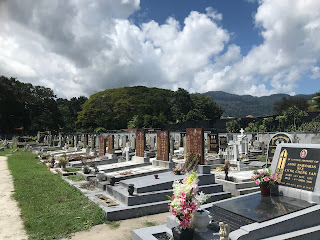There's a monthly newsletter sent around by mailing list by a long time resident English lady named Michelle who just loves this place and just loves organising things, or so it seems to me. Anyway first up was a tour of the old graveyards in Georgetown narrated by a guy we'd run into one of our other tours, Clement. Very informative it was too. Particularly as Georgetown has magnificent colonial heritage dating back to first inhabitation in 1786 under the purview of one Francis Light and his employers, the East India Company.
 |
| The Jackson family was particularly unfortunate |
First, there was a sort of NIMBY thing regarding graveyards so they were set aside well out of town (then anyway, not so now) and on land that was rather low lying that nobody really wanted to build upon anyway. A wall was built delineating the protestant side from the catholic side with the lower land (and hence far more prone to flooding) given over to the catholics. Typical.
 |
| The very ornate gravestones apparently are all Scottish families, but you can see the wall in the background |
Aaaagh! What a palaver. All these catholics but at least this lot were almost European. Can't have any of the new locals in the graveyards too.
Third, some of the locals (Chinese, Indians, Armenians, etc.) turned out to be terrific businessmen and did really well becoming extremely wealthy in the process. It also transpired that they were prone to dying too (although not so young as the newbies).
The upshot to all this was the typical British muddle/compromise. If you had the wherewithal, you were in.... except the catholics who went the other side of the wall.
 |
However the Japanese were no respecters of well, pretty much everything if you read about their actions in WWII and simply bombed the place to bits. Part of it anyway. The Catholic side was locked up so we couldn't go inside but looked pretty much empty of gravestones. If it wasn't the bombing, it was the flooding most like. No, most likely the protestants!
Spare a thought for the Jews though. They had been in Penang since the start but in far smaller numbers. Clement said the Jews that came to Penang were from the Middle East not Europe. Turkey, Persia, Mesopotamia. They were/are a different tribe to the Europeans and had their own ceremonies and ways. Francis Light when he set to creating Georgetown created enclaves for the various races and sects. The Jews had their own together with one synagogue and one graveyard.
 |
| The different Jewish tribes have different burial traditions. Some of the gravestones are triangular, some rounded. All are supposed to point towards Jerusalem. |
These days the main Christian graveyard is on Western Road and is pretty huge. Again the theme throughout is that they are beautifully maintained. Clement tried to raise some enthusiasm for this graveyard but in reality it was far less interesting than the older ones. Exception being the mausoleum remembering the crew of a Russian warship which had the misfortune to be visiting Penang at the outbreak of WWI. A German raider, the Emden, snuck in at dusk one day and sunk the Russian vessel with heavy loss of life. Thankfully not the captain... he was tucked up in bed at the E&O Hotel with his mistress. History relates that he was recalled and court martialled. Every year the Russian ambassador visits the site where a remembrance ceremony is held on the anniversary of the action. Clement said this happened even during the Soviet era. Nice.
By now, all were going through graveyard fatigue so clearly this was the time for the visit to the new catholic cemetery. Typical protestant bias! I've driven past the graveyard a hundred times, its on a main road, but had never seen it before so this was nice.
The names were mainly Chinese with a few Portuguese names like De Silva and Perreira thrown in for good measure along with some Indian and western names. But really... no trees! In every other cemetery there were lovely trees giving pleasant shade but here... nothing! Hope some get planted soon.



No comments:
Post a Comment